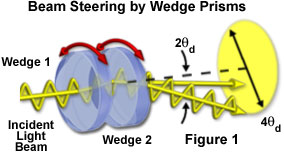Beam Steering by Wedge Prisms
Beam Steering by Wedge Prisms - Java Tutorial
Circular prisms having plane surfaces positioned at slight angles with respect to each other are termed optical wedges, and deflect light by refraction rather than reflection. Although wedges are prismatic in nature, they can be manipulated to act as beamsplitters or beam steerers. This interactive tutorial explores how two wedge prisms operate together to deflect an incident light beam.
The tutorial initializes with an incident light beam entering the first wedge prism (Wedge 1) of a pair where the angled face of the prism is facing the incoming wave. The light beam travels through the first prism, where it is refracted before entering the second prism (Wedge 2) of the pair. The light beam is refracted again by the second prism and is projected onto the yellow screen positioned on the right-hand side of the tutorial window. To operate the tutorial, use the Wedge Orientation slider to rotate the second prism (Wedge 2) and steer the beam up and down on the screen. The current steering angle is displayed above the slider bar. In situations where the first wedge prism can be rotated along with the second, the beam can be manipulated to sweep an arc around the screen.
The angle at which a wedge diverts incident light depends on the angle between the entrance and exit faces and the refractive index of the glass utilized to manufacture the plate. Wedge angles range between 2 and 25 degrees and have corresponding diopter powers between 2 and 20 centimeters deviation of the refracted light beam per meter of distance from the prism.

The direction of light refracted after passing through the wedge can be controlled by rotating the circular prism (see Figure 1). In many cases, two wedges are paired and the light path is altered to an even greater degree over a 360-degree range by rotating the wedges in opposite directions. Wedge prisms act as versatile beamsplitters to prevent ghost images and to steer light beams through adjustable pathways in optical systems.
Contributing Authors
Matthew J. Parry-Hill and Michael W. Davidson - National High Magnetic Field Laboratory, 1800 East Paul Dirac Dr., The Florida State University, Tallahassee, Florida, 32310.
Sorry, this page is not
available in your country.